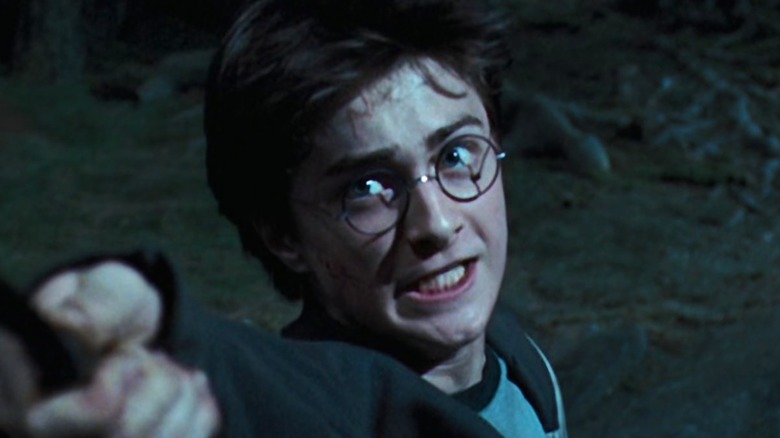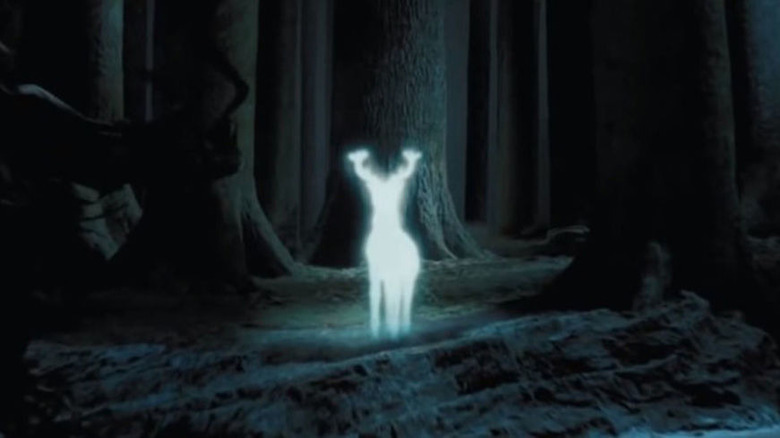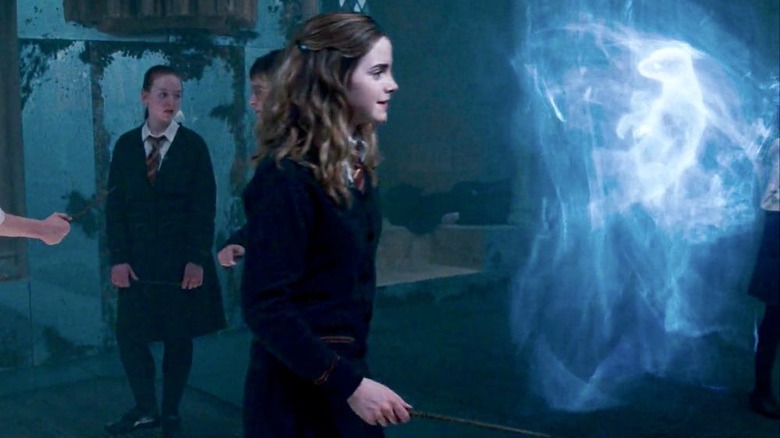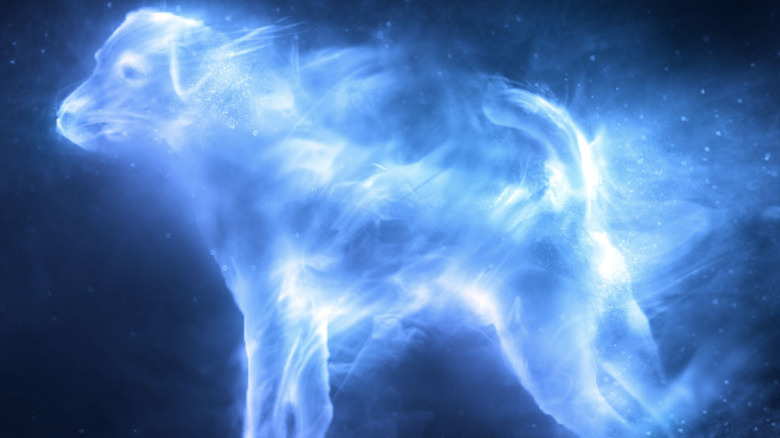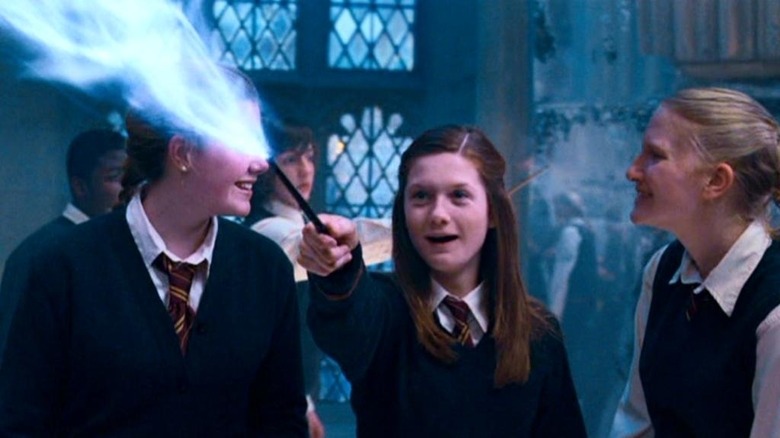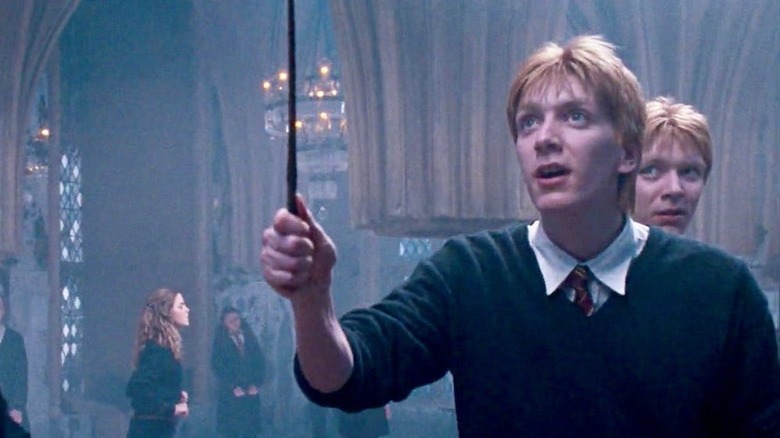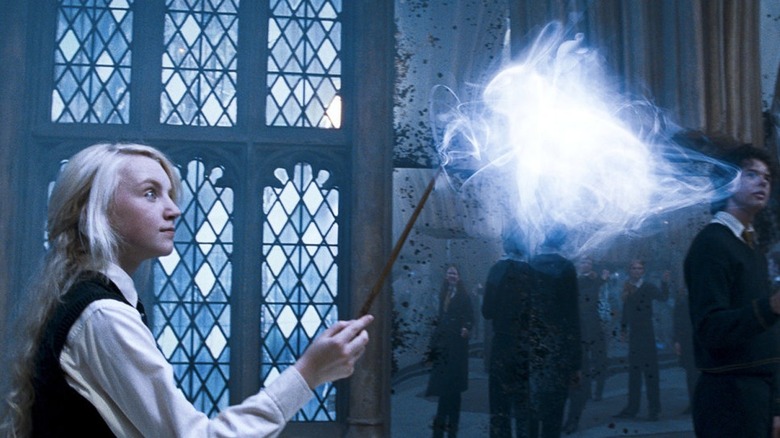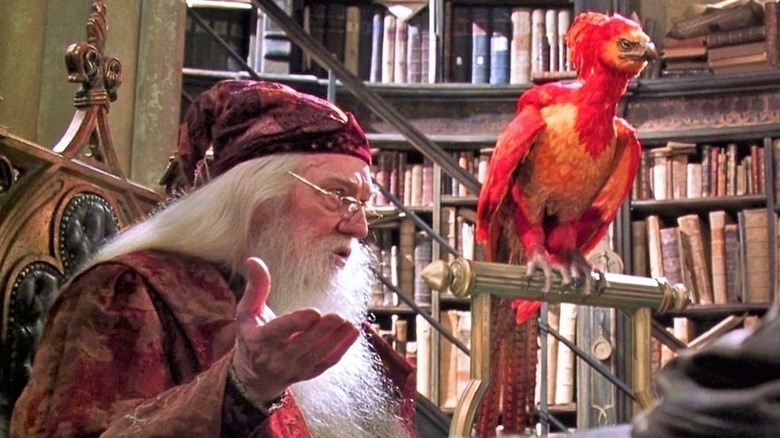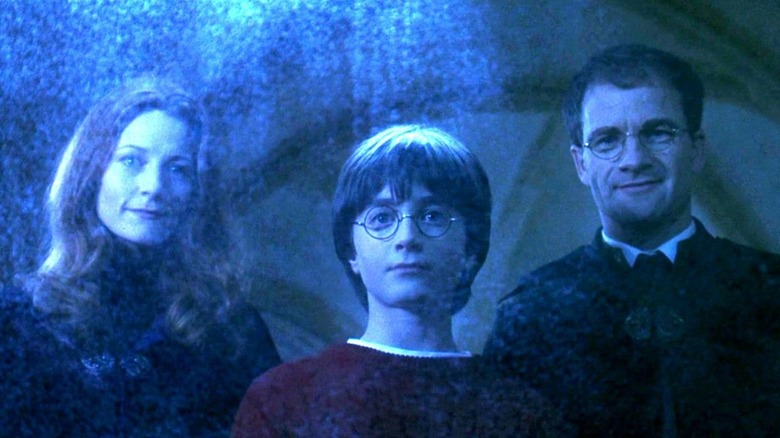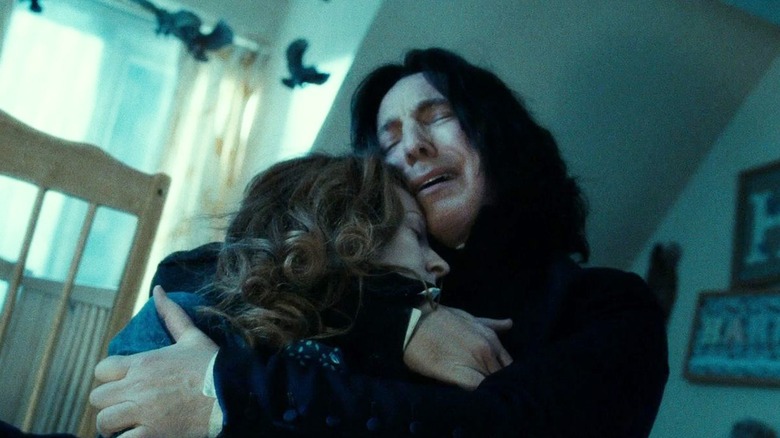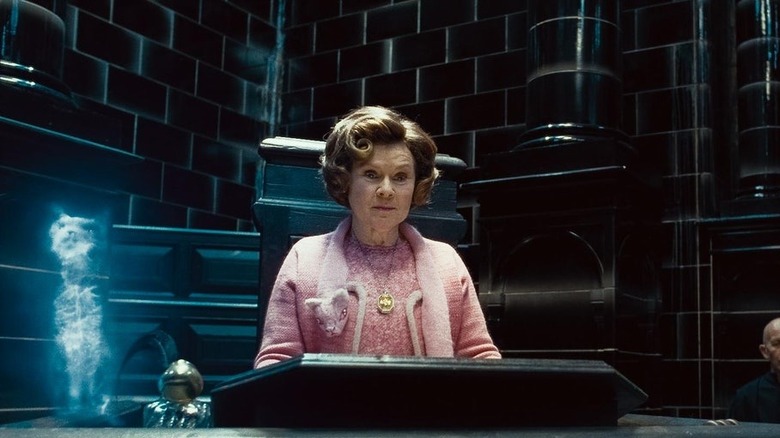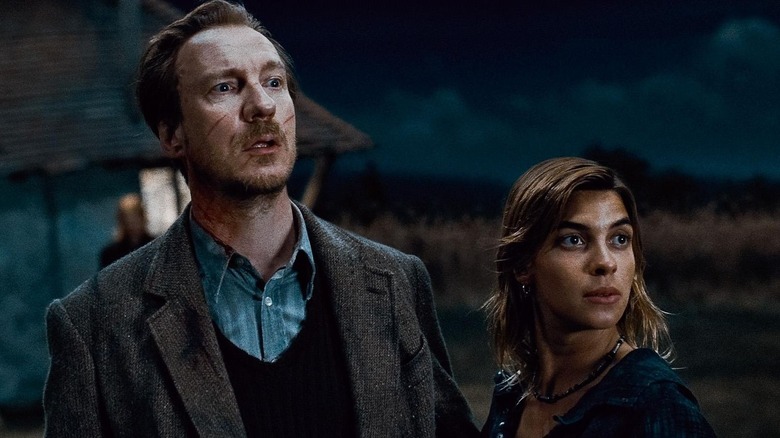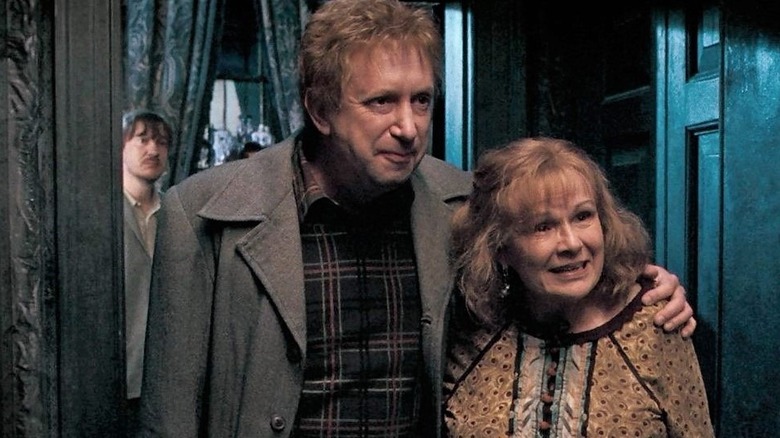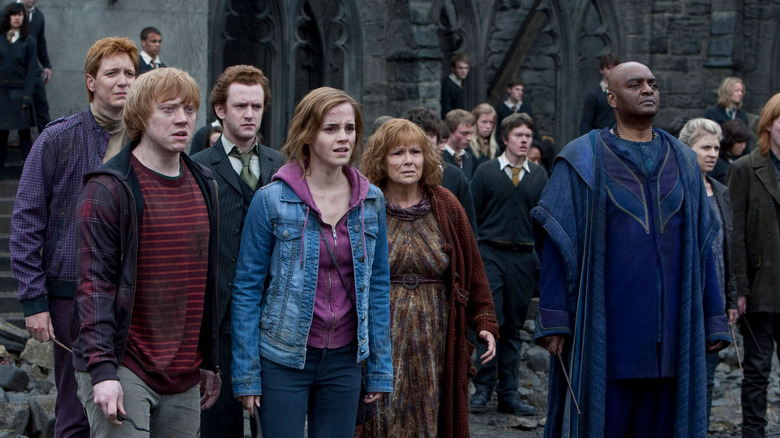Harry Potter: Every Main Character's Patronus Explained
In the Harry Potter universe, "A Patronus is a form of advanced magic in which the witch or wizard casting the spell draws upon their happiest memories to produce a kind of shield to help protect themselves from Dementors, the guardians of the wizarding prison, Azkaban," as Entertainment Weekly explains.
Professor Remus Lupin first teaches Harry how to conjure a Patronus after his encounter with the Dementors. As he explains to Harry in "Harry Potter and the Prisoner of Azkaban," a Patronus is "a guardian which acts as a shield between you and the Dementor ... a projection of the very things that the Dementor feeds upon –- hope, happiness, the desire to survive -– but it cannot feel despair, as real humans can, so the Dementors can't hurt it." As a result, Lupin says, it will only work, "if you are concentrating, with all your might, on a single, very happy memory," according to the Wizarding World.
There are two different kinds of Patronuses. One is a non-corporeal Patronus that can appear as "'a thin wisp' of silver that 'hovers like mist,'" according to Wizarding World. Neville Longbottom notoriously uses a non-corporeal Patronus throughout the series. However, when a witch or wizard is able to conjure a corporeal Patronus, it comes out in the form of an animal, and each animal is unique to the witch or wizard who conjures it. Harry, in turn, teaches his friends who join Dumbledore's Army how to conjure their own Patronuses. Here's how everyone's Patronus comes out and what it says about the character who summons it.
Harry Potter: Stag
Harry Potter's Patronus comes in the shape of a stag, emphasizing his deep connection to his parents, whose Patronuses are both deer as well. No other family in the "Harry Potter" universe shares a Patronus connection in the way that the Potters do. Harry starts learning about Patronuses in "Harry Potter and the Prisoner of Azkaban" after encountering the Dementors, dark shadowy beings that suck souls and make their victims feel incomparable sadness and despair. After his experience with the Dementors, Harry started taking anti-Dementor lessons from his teacher, Remus Lupin. During a Quidditch match against Ravenclaw, Harry casts his first corporeal Patronus when some Slytherin students were impersonating Dementors.
Harry's big moment of conjuring his Patronus came during the climax of "Harry Potter and the Prisoner of Azkaban." While he and Hermione are traveling through time, trying to save Sirius Black, Buckbeak, and themselves, Harry thinks he sees his father conjure a stag from across a frozen lake. As it turns out, the stag is summoned by his future self. Knowing he could already do it gave Harry the confidence to conjure it himself. "Out of the end of his wand burst, not a shapeless cloud of mist, but a blinding, dazzling, silver animal ... It was galloping silently away from him, across the black surface of the lake. He saw it lower its head and charge at the swarming Dementors," the book reads.
Hermione Granger: Otter
Much like many of the other characters in the "Harry Potter" universe, Hermione Granger conjures her very first Patronus in the Room of Requirement during a meeting of Dumbledore's Army in "Harry Potter and the Order of the Phoenix." Hermione's Patronus came in the form of a cute little river otter. These smart creatures are incredibly intelligent, just like Ms. Granger herself.
That Hermione's Patronus is a river otter marks a connection to Harry Potter creator J.K. Rowling. According to Insider, "Rowling based Hermione's Patronus on her favorite animal. It makes sense that Rowling would choose her favorite animal for Granger. The author has said that she sees much of herself in the young wizard." In The Guardian, Rowling says, "I have often said that Hermione is a bit like me when I was younger. I think I was seen by other people as a right little know-it-all, but I hope that it is clear that underneath Hermione's swottiness there is a lot of insecurity and a great fear of failure."
Ron Weasley: Jack Russell Terrier
There's nothing more loyal than a dog. Ron may not have always lived up to his best friend Harry's expectations of him, and he certainly had his moments of doubt. He occasionally had moments of jealousy against Harry, and his decision to leave the quest during "Harry Potter and the Deathly Hallows: Part 1" was also a bit of a bummer.
Even so, Ron's loyalty to Harry and the love of his life, Hermione Granger, always remains steadfast. So it makes perfect sense that Ron's Patronus would come in the shape of a loving and loyal dog. During "Harry Potter and the Order of the Phoenix," while Dumbledore's Army is practicing their Patronus charms in the Room of Requirement, Ron's little dog Patronus bursts forth from his wand. It looks like Ron's Patronus is specifically a Jack Russell Terrier, and terriers are commonly known to be incredibly loyal pets.
Additionally, both Ron and Hermione's Patronuses appear during the Battle of Hogwarts. As described in "Harry Potter and the Deathly Hallows," "He saw Ron's silver terrier burst into the air, flicker feebly and expire; he saw Hermione's otter twist in mid-air and fade, and his own wand trembled in his hand, and he almost welcomed the oncoming oblivion, the promise of nothing, of no feeling ..."
Ginny Weasley: Horse
Interestingly enough, Ginny Weasley, Harry's future wife, conjures up her Patronus form in the shape of a horse. Though Ginny's Patronus animal was never detailed in the books, in films it was a horse, which is absolutely fitting for the strong-spirited character.
The horse Patronus that appears in "Harry Potter and the Order of the Phoenix" while Dumbledore's Army is practicing in the Room of Requirement is quite wild, free, and fierce. It gallops throughout the room, blazing its own path and not letting anything get in its way. Ginny might not have appeared that wild and free in the films, but her spirit was exactly that in the books, which is probably why Harry was so drawn to her. He is always quite hesitant and at times feels restricted, but Ginny's freeness allows him a sense of something different. Her horse Patronus epitomizes that wild feeling.
Fred and Georg Weasley: Magpies
Twins Fred and George Weasley are the fun, dynamic duo of the Weasley family. The two often play pranks, get into trouble, and generally tease and terrorize their younger siblings Ron and Ginny, albeit out of love. They become a part of Dumbledore's Army in 'Harry Potter and the Order of the Phoenix" just as many others did, where they learn how to conjure their magpies to assist in the fight against Voldemort.
Like so many other things, Fred and George Weasley share the same Patronus, the magpie bird. Though we don't see that Patronus form itself in the films, Harry Potter creator J.K. Rowling revealed the animal on her Twitter account, where she wrote, "Magpies. I thought I'd said that before? We have a saying about them in the UK, 'one for sorrow, two for joy,' as you might know. Plus, they're talkative thieves." The one for sorrow, two for joy saying cuts even deeper knowing how the Battle of Hogwarts ends with Fred's death.
Luna Lovegood: Hare
That wacky Luna Lovegood. The character that Harry, Ron, and Hermione were first wary of because of her loony reputation turns into a loyal and faithful friend, as well as a creative thinker and all-around fun person. Luna never shies away from speaking the truth, even if it makes others uncomfortable. Though her weird ways might frighten others off, the central trio finds in her a good friend. Her Patronus is a small hare, aka a rabbit, and she even manages to use the spell during an intense moment at the Battle of Hogwarts.
Author J.K. Rowling gave the actress who plays Luna, Evanna Lynch, a silver hare charm that Lynch turned into an earring, something she cherishes. However, Lynch revealed that something fishy happened when she took the Patronus quiz on the Pottermore website. She answered all of the questions but didn't get a hare at all. Instead, she got — a salmon.
Albus Dumbledore: Phoenix
It's no surprise that Hogwarts Headmaster Albus Dumbledore's Patronus is none other than the mythical phoenix. His pet phoenix, Fawkes, has saved the lives of Harry, Dumbledore, and numerous others on many occasions throughout the Harry Potter series. The mythical creature superbly represents the wise, old, magical person that Dumbledore is, and its ability to reincarnate mirrors Dumbledore's lingering presence throughout Harry's life.
With his phoenix Patronus, Dumbledore also invents a new way of using the charm that wasn't simply for fighting off Dementors or other evil spells. Dumbledore uses his Patronus to communicate, sending messages via the fully formed animal. Sending messages this way was inherently "dark arts proof," as the Patronus identifies the sender but only as known to the recipient. For example, Dumbledore uses his phoenix Patronus in "Harry Potter and the Goblet of Fire" after Viktor Krum is stunned. "He raised his wand into the air and pointed it in the direction of Hagrid's cabin. Harry saw something silvery dart out of it and streak away through the trees like a ghostly bird," the passage reads.
James and Lily Potter: Stag and Doe
Harry Potter's father, James, conjures a stag as his Patronus, just like his son. However, fans will recall that it isn't just his Patronus that takes the shape of a stag. James also transforms into a stag as well. James is an Animagus, a human that can transform themselves at will into an animal. While students at Hogwarts School of Witchcraft and Wizardry James and his friends, Sirius Black and Peter Pettigrew, learn pretty early on in their school careers how to become an Animagus in support of their friend Remus Lupin, who is a cursed werewolf. James' ability to turn into a stag earned him the nickname Prongs, while Sirius Black goes by Padfoot for his black dog form, Peter Pettigrew is known as Wormtail for his mouse form, while Lupin earns the nickname Moony.
However, J.K. Rowling indicated that James' Patronus may not have always been a stag. As she wrote during a live chat, "The Patronus often mutates to take the image of the love of one's life (because they so often become the 'happy thought' that generates a Patronus)." So James's may have had a different Patronus when he was younger before he met Lily, whose Patronus was a doe. James' love for Lily makes her his happy thought, which could lead to his Patronus probably morphed to match hers. Of course, Lily wasn't the only one with a doe Patronus. Someone else matches hers even more directly.
Severus Snape: Doe
Learning that Severus Snape was in love with Lily Potter for his entire life makes his story all the more tragic. Through flashbacks in "Harry Potter and the Deathly Hallows: Part 2," we see how he and Lily were childhood friends and that his love for her starts young. His deep feelings for Lily create a situation in which he simultaneously hates Harry, the offspring of James, but also wants to keep him safe as he was the most precious thing in the world to Lily. Snape remains a Death Eater under Voldemort's watchful eye as a spy and protects Harry, all while trying to work both sides.
As a result, Snape's Patronus matches Lily's. His doe is just like hers, the female version of a deer, not a stag like James'. It was Snape's doe that Harry sees in "Harry Potter and the Deathly Hallows: Part 1" that leads him to the sword of Godric Gryffindor frozen in a lake. When Harry relives Snape's memories as Snape lays dying, he witnesses a conversation Snape has with Dumbledore, wherein Snape reveals his Patronus. The description of Snape's Patronus in the books reads, "From the tip of his wand burst the silver doe: she landed on the office floor, bounded once across the office and soared out of the window. Dumbledore watched her fly away, and as her silvery glow faded he turned back to Snape, and his eyes were full of tears. 'After all this time?' 'Always,' said Snape."
Minerva McGonagall and Delores Umbridge: Cat
Professor McGonagall is also an Animagus who can turn herself into a cat. Audiences got to see her slick feline form in the very first film, "Harry Potter and the Sorcerer's Stone." So it makes perfect sense that her Patronus is also a cat. Professor McGonagall also uses her Patronus during the Battle of Hogwarts as a messenger Patronus. The description of McGonagall's Patronus in "Harry Potter and the Deathly Hallows" reads that Professor McGonagall "marched towards the door, and as she did so she raised her wand. From the tip burst three silver cats with spectacle markings around their eyes. The Patronuses ran sleekly ahead, filling the spiral staircase with silvery lights."
However, cats were also the favorite animal of the horrible Delores Umbridge, the Defense Against the Dark Arts teacher turned Ministry High Inquisitor turned Headmistress of Hogwarts who has kitschy cat plates lining her walls and figurines throughout her office. She is notoriously cruel to students, often physically abusive, as is seen when she forces Harry to copy lines that burn their way into his hand in "Harry Potter and the Order of the Phoenix.". Her Patronus is seen in "Harry Potter and the Deathly Hallows: Part 1" during Umbridge's prejudiced interrogation of Muggle-borns. The silvery cat sits right beside her, warding off the Dementors that float in the air above the poor witches and wizards being tormented by her inquisition.
Remus Lupin and Nymphadora Tonks: Wolf
Now, Nymphadora Tonks' Patronus didn't start as a wolf. In the books, Tonks first has a hare as her Patronus, like Luna Lovegood. However, like with James and Lily Potter, Tonks, who doesn't like to be called Nymphadora, as we all know, changes hers to a wolf to match that of her love, Remus Lupin.
As is detailed in "Harry Potter and the Half-Blood Prince," "Tonks' Patronus has changed its form,' he told him. 'Snape said so, anyway. I didn't know that could happen. Why would your Patronus change?' Lupin took his time chewing his turkey and swallowing before saying slowly, 'Sometimes ... a great shock ... an emotional upheaval ...' 'It looked big, and it had four legs,' said Harry, struck by a sudden thought and lowering his voice. 'Hey ... it couldn't be –?' That was when Harry realizes Tonks' love for the gruff, silent, often stoic Lupin, whose own Patronus takes the shape of a wolf due to his lycanthropy. However, Lupin often hides the proper form of his Patronus, instead opting to have it appear on a non-corporeal form.
Arthur Weasley: Weasel
Sure, it's a little silly that Ron Weasley's father Arthur Weasley's Patronus is a literal weasel. That's taking things a bit too literally. However, weasels are mischievous and fun, much like Arthur's personality. Arthur doesn't use his Patronus a lot to defend against Dementors or other Dark Arts. Instead, he uses it mainly as a form of communication.
First, he sends a message about Rufus Scrimgeour's arrival on Harry's 17th birthday in "Harry Potter and the Deathly Hallows." Arthur also uses a messenger Patronus to let Harry, Ron, and Hemione know that the whole Weasley family is safe while they're at Number 12 Grimmauld Place. As the book describes it, "Harry drew his wand again and spun round to see a silver Patronus soar through the drawing-room window and land upon the floor in front of them, where it solidified into the weasel that spoke with the voice of Ron's father."
Everyone else
A few other Patronuses make their appearance in the "Harry Potter" films with some backstory from the books. Seamus Finnigan's Patronus is a fox, Cho Chang has a swan, and Ernie MacMillan has a boar. During the Battle of Hogwarts, "Harry Potter and the Deathly Hallows" reads, "then a silver hare, a boar and a fox soared past Harry, Ron and Hermione's heads: the Dementors fell back before the creatures' approach. Three more people had arrived out of the darkness to stand beside them, their wands outstretched, continuing to cast their Patronuses: Luna, Ernie and Seamus."
Professor Dumbledore's brother Aberforth, owner of the Hog's Head Inn, has a goat, much like the goats he cared for, though that Patronus doesn't make it into the films. Also in "Deathly Hallows," Aberforth convinces a gaggle of Death Eaters looking for Harry after seeing his stag Patronus that they had seen his goat Patronus instead.
Kingsley Shacklebolt also has a pretty cool Patronus — a lynx. The slick, big cat is perfect for Kingsley. The powerful Auror drops his lynx Patronus right in the middle of Bill Weasley and Fleur Delacour's wedding. "Deathly Hallows" reads, "Graceful and gleaming, the lynx landed lightly in the middle of the astonished dancers. Heads turned, as those nearest it froze, absurdly, in mid-dance. Then the Patronus's mouth opened wide and it spoke in the loud, deep, slow voice of Kingsley Shacklebolt. 'The Ministry has fallen. Scrimgeour is dead. They are coming.'"
